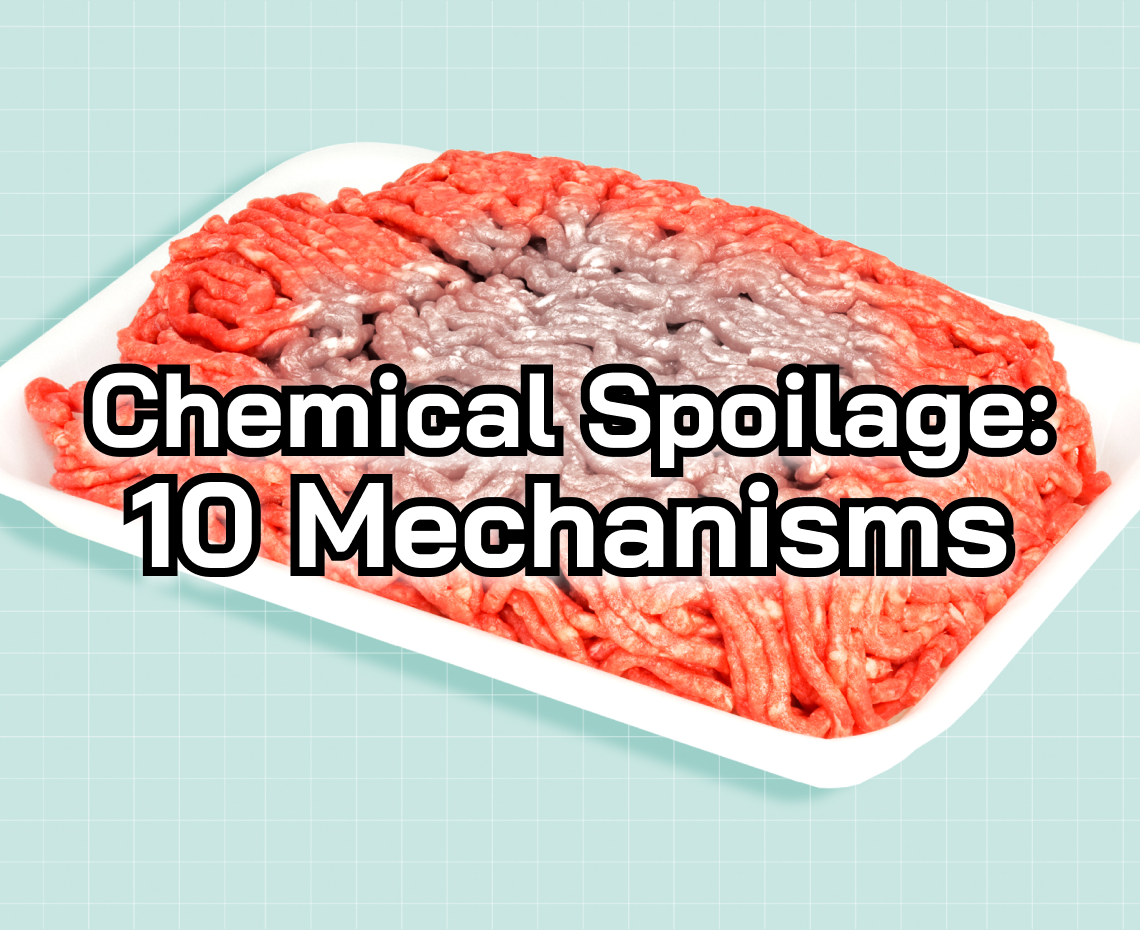Chemical Food Spoilage: 10 Mechanisms

Chemical changes are always involved in Food Spoilage. Many times, the presence of microorganisms causes these changes, which we refer to as 'microbial spoilage.' However, in the absence of microorganisms, many other types of chemical reactions limit the shelf-life of products. We refer to these chemical reactions as 'chemical spoilage.' The two categories of spoilage –chemical and microbial– can happen simultaneously or promote one another.
With this in mind, the following list describes the many different categories of chemical spoilage. These categories are not 100% exclusive and do overlap. In future posts, these categories will be explored in more detail with specific examples to illustrate the interactive nature of spoilage reactions.
10 Mechanisms of Chemical Food Spoilage
1. Senescence
Senescence is referring to old age. When products run out of energy, they lose the ability to maintain their integrity. Senescence can precipitate a wide variety of other failure modes.
2. Over-Ripening
Over-ripening occurs with the extra activity of hydrolytic enzymes that soften and sweeten foods, mainly fruit. Over-ripening often precipitates microbial growth. However, the shelf-life is typically already exhausted when this microbial growth occurs.
3. Oxidative Rancidity
Oxidative Rancidity refers to the perceived fruity 'off' flavor or smell caused by the oxidation of fats in food. Oxidative Rancidity is an autocatalytic reaction initiated by oxygen.
4. Loss of Vitamins
Vitamins are essential nutrients and are subject to many reactions. The most prominent loss of vitamins relates to the oxidation of the antioxidant Vitamins A, C, and E. However, in some respects, this group is a catch-all for several diverse reactions.
5. Color changes
Undesirable color loss or gain in a food product. Since food pigments interact with visible light, many are susceptible to bleaching. For example, the effects of oxidation, polymerization, and condensation can generate undesirable browning.
6. Degradation of Proteins
Proteins are vital to the structure and function of many foods. Proteins lose structure and function when they are hydrolyzed and/or oxidized. Some of the loss of form and function of proteins are associated with the freshness of protein-containing foods. For example, using an old egg white when making angel food cake will result in less rise and fluff of the cake.
7. Condensation reactions (Maillard Browning and others)
Condensation reactions are the browning reactions resulting from exposure to heat. These reactions are involved in toasting, caramelization, and other cooking processes. Although we all love a nice toasted bagel, these reactions occur in other foods at slower rates where the browning is undesirable.
8. Photochemical
Photochemical spoilage refers to the degradation of food components due to exposure to light. These reactions overlap with color changes and the loss of vitamins. The customer's desire to see a product before purchase makes controlling these reactions difficult.
9. Decarboxylation
Decarboxylation is the loss of oxygenated carbon with carbon dioxide production. Foods can lose important flavor compounds through oxidation and generate carbon dioxide causing packages to swell.
10. Staling
Staling describes changes in the food (generally starchy baked items) that reduce palatability by impacting taste, causing dryness, and producing leathery textures. The changes are related to the partial recrystallization of starch grains that swelled during the cooking process.
Need Shelf-Life Testing?
AEMTEK has been a trusted provider of shelf-life testing for over two decades. Our Ph.D. Scientists custom-design each study based on the quality and safety risks of the individual product, so you can be sure you are getting the most accurate understanding of your product's shelf-life. With various storage conditions and acceleration levels, to direct access to our scientists, we are confident you will love our services.

.png)
.png)